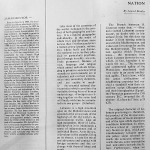THE DISTINCTIVE PERSONALITY OF THE LEBANESE NATION
By Jawad Boulos
Like most of the countries of the word, Lebanon is the product of both geography and history, if is natural geographic individuality, in the midst of which lives and develops since no less than five thousand years a human group (people, nation, etc.) whose basic and distinctive national traits, be they physical or particularly psychological through heredity, are relatively permanent. Matters of race, language and religion which united individuals belonging to primitive societies (tribal nomads or semi-nomads) are in sedentary and evolved communities very secondary elements, and are unable to modify the essential national characteristics which constitute the veritable driving force of human undertakings. “Foreign races living together on the same land will finally with time be assimilated into one group”. (Schubart).
Lebanon is a high mountain open on the Mediterranean and situated at the crossroads of the highways of the old world’s intercontinental traffic. Like all high mountains, those of Lebanon develop in its inhabitants a sense of independence and of individual liberty. As to the sea, it develops in the peoples living on its shores, a taste for travel and adventure and contact with foreign countries and the exchange with them of ides and goods.
Lebanon’s vocation is, therefore, commercial, maritime and cultural: this particular character has constantly impressed the country Lebanon all through its long and normal historical evolution, through a historical process covering several millennia.
The French historian R. Grousset notes that: —- “Phœnicia (actual Lebanon) communicates no doubt with its hinterland Syria; but this does not hinder it from turning entirely towards the Mediterranean, and it does not live except for and by the Mediterranean. The mountain against which Phœnicia leans… the mountain from which it comes down to the sea, which, in fact, launches it towards the sea… The maritime and commercial agility of the Phœnicians manifested itself very early in an acute intellectual agility. That is how, whilst the great civilizations of neighboring countries had reached a standstill with their cuneiform script (Mesopotamia) and their hieroglyphics (Egupt), the Phœnician genius in the 15th century B.C. invented the Alphabet”. (La face de l’Asie, p.23 n25).
The original character of Lebanese psychology is, therefore, the product of the diverse natural conditions of its environment and of the type of life that these conditions determine. In short, we have a host of contradictory factors in play, which pull simultaneously towards opposite poles: some oriented towards the continent, others towards the sea, some towards the past and others toward the future. Furthermore, when we talk of the two facets of present Lebanon, is it sufficient to interpret this fact as being the expression of the political union of the two important religious communities of the country: the Christians and the Moslems. It is also determined by the double front occasioned by the geography of this small country of which one side has its eyes turned towards the sea, and the Western world, while the other side looks towards the continent and the Eastern world, with all the complex phenomena which such a double orientation may provoke in the country in the economic, psychological, cultural, social and political domains; all this independently of the influence of racial factors and religious ideas.
In conclusion, “the physical characteristics of Lebanon are the basics of its human resources. It is geography that permitted its birth and that ensures its perennity… In this unity, be it the mountains or the coast, each has its role. The mountain conveys to the country its fundamental trait of individuality; it is the political and military refuge and the driving force of independence… Economically, it is the coast with its ports and plains which are so essential… Unity in diversity. The psychic landscape corresponds to the geographic landscape. Be it in economy or in politics, we everywhere come across this double attraction: it was initially inscribed in the geography”.
